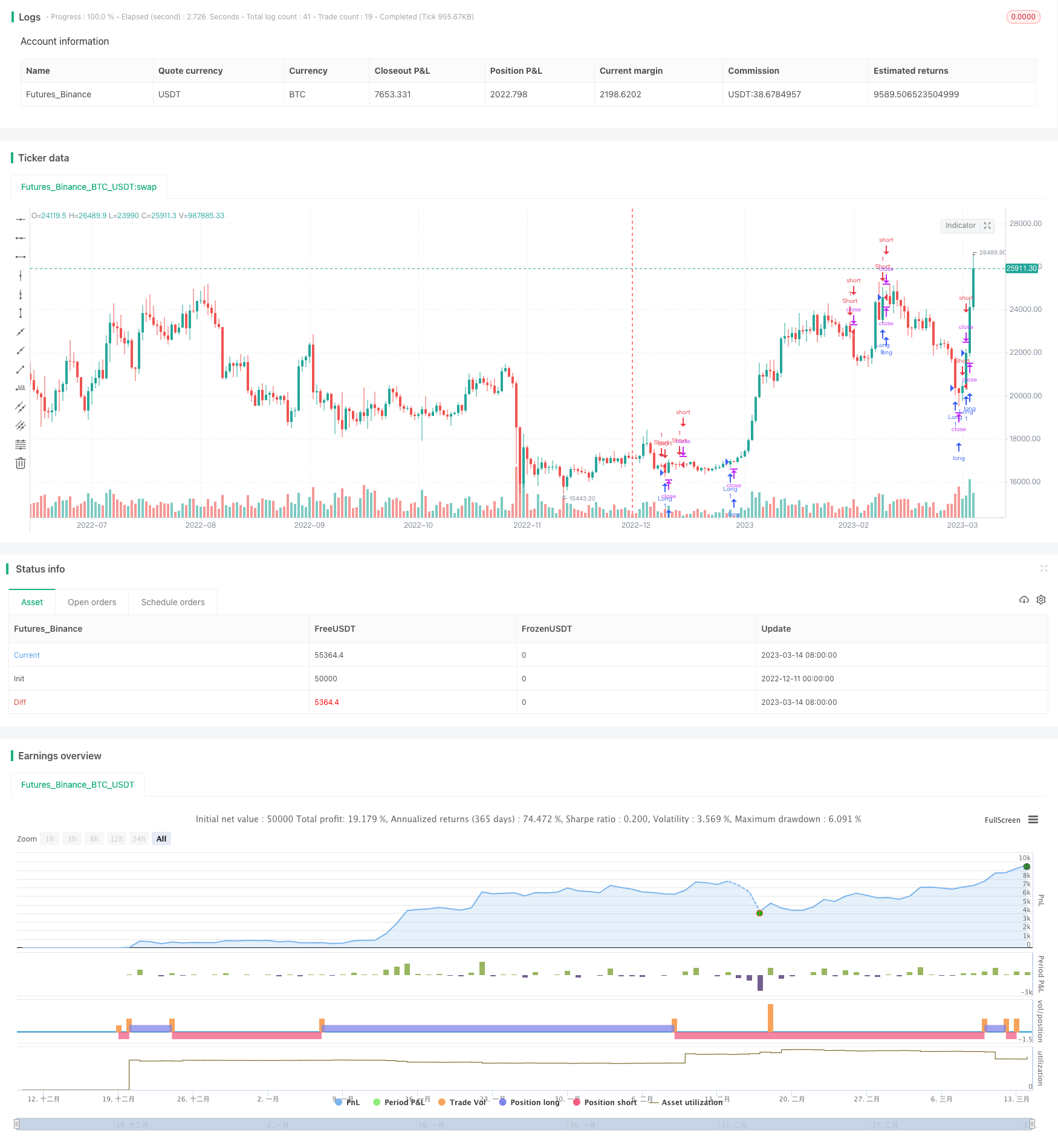
概述
本文主要分析一种名为“应用贝叶斯条件判断的RSI交易策略”的量化交易策略。该策略通过计算RSI指标的概率分布,应用贝叶斯法则推算RSI指标继续上涨或下跌的概率,以判断未来价格趋势,实现盈利。
策略原理
该策略的核心逻辑是:
- 计算一定周期内收盘价是否上涨的概率分布A
- 计算相应周期内RSI指标是否继续上涨的概率分布B
- 应用贝叶斯法则,计算A和B同时发生的概率
- 当该概率高于阈值时,判断趋势会继续,采取交易信号
具体而言,策略先定义参数p为计算RSI指标的周期参数,r为预测未来价格变化的时间范围。然后在p周期内,统计收盘价是否上涨的次数,计算概率分布A。同时在p周期内,统计该周期结束后r周期内,RSI是否继续上涨的次数,计算概率分布B。
之后,应用贝叶斯法则公式,计算同时满足“收盘价上涨”和“RSI继续上涨”这两个条件的概率,作为最终概率判断指标。当该概率高于给定阈值时,判断趋势会持续上涨,采取做多交易;当概率低于阈值时,判断趋势反转,采取平仓。
这样,策略综合考虑了价格信息和技术指标信息,应用概率统计和贝叶斯法则,对未来趋势做出判断,实现交易信号的产生。
策略优势
该策略主要有以下优势:
结合多种信息:策略不仅考虑价格信息,也结合了RSI等技术指标信息,综合判断未来趋势,提高判断准确率。
概率预测:通过统计概率分布,对价格和RSI变化方向做出概率预测,而不是简单的数值比较,使判断更科学。
贝叶斯优化:运用贝叶斯法则计算相关概率,对原始统计概率进行优化,使判断更准确。
灵活参数:提供多种参数进行调整优化,能够针对不同市场和资产进行参数拟合,提高策略适应性。
简单有效:策略思路清晰,通过简单统计与概率运算实现交易信号判断,易于理解与优化,且效果明显。
策略风险
该策略也存在以下主要风险:
参数依赖:策略效果依赖参数设置,不同市场需要调整大量参数才能达到最佳效果,增加策略运维难度。
概率错误:由于统计时间和样本有限,计算所得概率可能与真实趋势不符,导致判断产生偏差。
特殊事件:重大突发事件可能影响市场价格与RSI指标的相关性,使策略失效。
技术指标失效:在某些市场情况下,RSI等技术指标可能会产生失效信号,导致策略判断失败。
对应风险的解决方法包括:优化参数设置流程、调整统计时间和样本量、结合更多auxiliary信息、人工干预异常情况等。
策略优化
该策略的主要优化方向有:
多时间框架:可以在多种时间周期(日线、周线等)上运行策略,综合判断,提高稳定性。
更多指标:加入更多技术指标信号,如K线形态、运动平均线等,丰富判断依据。
模型优化:应用机器学习等方法,对贝叶斯模型进行优化,使计算更准确。
动态参数:加入参数的动态优化模块,使参数可以根据实时市场变化进行调整。
风控机制:设定最大回撤、做单频次等风控指标,避免极端市场中巨额亏损。
集成改进:与其它类型策略或模型集成,形成投票机制,提高判断的稳定性。
总结
本策略首先统计价格和RSI指标的概率分布,然后利用贝叶斯法则计算复合概率,在概率高于给定阈值时产生交易信号,实现盈利。该策略综合多源信息,应用概率预测和贝叶斯优化,判断效果较好。主要优化方向包括时间框架扩展、指标增多、参数动态化等。总体来说,该策略思路独特,效果显著,非常值得探索与应用。
/*backtest
start: 2022-12-11 00:00:00
end: 2023-03-15 00:00:00
period: 1d
basePeriod: 1h
exchanges: [{"eid":"Futures_Binance","currency":"BTC_USDT"}]
*/
//@version=2
// Stealthy7 trading scripts are radikal. You have entered the mystical realm of demonic profit.
// If you like this script, check out my bots at cryptotrader.org/?r=51
// Let me know if you find any improvements to this script. It is beta.
// Please subscribe.
strategy("Stealthy7 Bayes Conditional RSI Trader Strategy", overlay=true)
p = input(title="Period", defval=30, minval=5, maxval=500)
t = input(title="Movement Thresh", type=float, defval=1.003, minval=1.001, maxval=1.5, step=0.001)
r = input(title="Look Range", defval=7, minval=1,maxval=500, step=1)
RSIT = input(title="Jump", defval=8, minval=1,maxval=99, step=1)
BAYEST = input(title="SM", defval=3, minval=1,maxval=99, step=1)
RSIP = input(title="RSIP", defval=14, minval=2,maxval=100, step=1)
countup = 1
countdn = 1
countupS = 1
countdnS = 1
for i = p to 1
if close[i]/close[i + r] > t
countup := countup + 1
else
countdn := countdn + 1
if close[i]/close[i + r] < 2 - t
countupS := countupS + 1
else
countdnS := countdnS + 1
rsi = rsi(open,RSIP)
countup2 = 1
countup3 = 1
countup2S = 1
countup3S = 1
for i = p to 1
if close[i]/close[i + r] > t and rsi[i + r + 1] > rsi[i + r + 2] + RSIT
countup2 := countup2 + 1
else
countup3 := countup3 + 1
if close[i]/close[i + r] < 2 - t and rsi[i + r + 1] < rsi[i + r + 2] - RSIT
countup2S := countup2S + 1
else
countup3S := countup3S + 1
countup2b = countup2 / p
countup3b = countup3 / p
countupb = countup / p
countdnb = countdn / p
countup2bS = countup2S / p
countup3bS = countup3S / p
countupbS = countupS / p
countdnbS = countdnS / p
bayes = 0
bayes := ((countupb * countup2b) / ((countupb * countup2b) + (countdnb * countup3b))) * 100
bayesS = 0
bayesS := ((countupbS * countup2bS) / ((countupbS * countup2bS) + (countdnbS * countup3bS))) * 100
SN1 = sma(bayes,BAYEST)
SN2 = sma(bayesS,BAYEST)
shortCondition = crossunder(bayesS, SN2) //and rsi < 49
longCondition = crossover(bayes, SN1) //and rsi > 59
if (longCondition)
strategy.entry("Long", strategy.long)
if (shortCondition)
strategy.entry("Short", strategy.short)